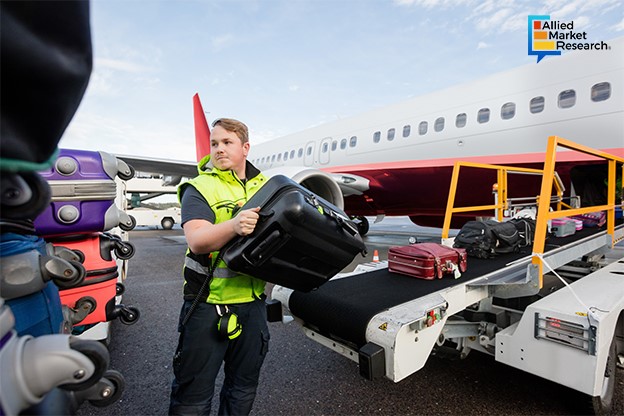A Comprehensive Overview of Tech-Driven Transformation in Airport Ground Operations

26 Dec
2024
Highlights:
- Introduction
- Streamlining the process through robotics
- 35th IATA in May 2023 emphasizing the need for automation
- Big data and predictive analytics for efficient resource allocation
- Monitoring systems through IoT sensors and real-time data
Ground handling operations encompass a wide range of activities, including aircraft marshaling, baggage handling, catering services, refueling, and cargo loading or unloading. These tasks are typically performed by a team of skilled personnel, utilizing specialized equipment such as tugs, dollies, and cargo loaders.
Innovations such as automation, artificial intelligence, and data analytics have significantly changed how airports manage their tasks. Technology has reduced delays, cut costs, and enhanced accuracy by streamlining the entire process. Ground handling teams now depend on real-time data and advanced systems to optimize their work, leading to faster turnaround times and a smoother passenger experience.
Streamlining the process through robotics
Automation has streamlined many labor-intensive tasks, reduced human error, and improved efficiency. Autonomous vehicles are now used to transport baggage, cargo, and ground support equipment across airport terminals. These vehicles use sensors, GPS technology, and ML to move through the busy airport environment safely, avoiding obstacles and optimizing routes. Robotic systems also play a major role in aircraft servicing. Robots clean aircraft, de-ice, and refuel. These machines work continuously without breaks, ensuring that processes are carried out more quickly and consistently. The adoption of robotics in ground operations reduces turnaround times for aircraft and increases overall productivity.
35th IATA in May 2023 emphasizing the need for automation
At the 35th International Air Transport Association of Ground Handling Conference, held in Abu Dhabi in May 2023, digitization and automation were highlighted as main priorities for the ground handling sector. Monika Mejstrikova, IATA's Director of Ground Operations, emphasized during the conference's opening day that adopting global standards and accelerating the shift to digitization and automation would be essential for building resilience and ensuring sustainability within the industry. IATA also noted that upgrading to advanced ground support equipment can lower ground damage costs by 42% while also creating a safer working environment. This is expected to contribute significantly to the airport ground handling market.
Monitoring systems through IoT sensors and real-time data
The IoT has also reformed the way airports monitor and manage ground-handling operations. The devices embedded in vehicles, baggage carts, and cargo containers provide real-time data, helping ground handling teams improve their operations. For instance, RFID tags on luggage and cargo help airport staff track items in real time, ensuring they reach the right destination quickly. This technology reduces the risk of lost baggage and delays, improving communication between staff members.
IoT sensors are also used to monitor the condition of ground support equipment. These sensors alert maintenance teams about potential issues before they lead to breakdowns, gathering data on factors such as fuel levels, tire pressure, and mechanical health. This predictive maintenance prevents costly delays and enhances the reliability of airport operations. In 2022, Xovis implemented Bluetooth and Wi-Fi signals from passengers' mobile devices to track movement through Frankfurt Airport. This system provided real-time updates on wait times at security checkpoints and optimizes terminal operations based on passenger flow data.
Utilizing big data and predictive analytics for efficient resource allocation
Airports collect vast amounts of data from various sources, such as flight schedules, baggage handling systems, and ground support equipment. The authorities identify patterns and trends that lead to more efficient resource allocation by analyzing this data. For example, predictive analytics forecast peak demand periods for baggage handling, enabling ground service providers to deploy the right number of staff during busy times. In 2023, A large airport in the U.S. implemented a custom analytics solution suite developed by GainInsights to improve operational efficiency and passenger experience. This solution resulted in a 20% increase in passenger satisfaction and a 12% reduction in operating costs, demonstrating the effectiveness of data-driven decision-making.
Moreover, AI-powered systems help airlines and ground handlers manage resources more effectively by analyzing data and predicting demand. It optimizes the scheduling of ground crew based on factors such as flight arrivals, passenger numbers, and weather conditions. ML algorithms are particularly useful in predictive maintenance. These systems analyze patterns of equipment use and can predict when a piece of ground support equipment needs maintenance or replacement. This reduces the chances of unplanned breakdowns, ensuring smoother operations and avoiding costly repairs. Airbus collaborated with Air France-KLM in April 2023 to develop predictive maintenance solutions using AI and machine learning. This partnership aimed to enhance the reliability of ground support equipment by predicting maintenance needs, thereby reducing unplanned downtime and improving overall operational efficiency.
Endnote
Ground handling operations are evolving rapidly with the integration of advanced technologies. Automation, AI, and real-time data collection have transformed tasks that were once time-consuming and prone to error. These innovations optimize operational workflows, ensure faster processing times, and improve safety standards across airports. Airports have become more efficient and better equipped to handle the growing demands of the aviation industry by utilizing data for predictive maintenance and resource management.
To get more business trends and expert advice on the airport ground handling industry, feel free to talk to our industry specialists here!

Koyel Ghosh
Author’s Bio- Koyel Ghosh is a blogger with a strong passion and enjoys writing in miscellaneous domains, as she believes it lets her explore a wide variety of niches. She has an innate interest in creativity and enjoys experimenting with different writing styles. A writer who never stops imagining, she has been serving the corporate industry for the last five years.
Exploring the Rise of LEDs: A Cost-Effective and Eco-Friendly Solution for Aircraft Cabin Lighting
Avenue: Entire Library membership of Allied Market Research Reports at your disposal
- Avenue is an innovative subscription-based online report database.
- Avail an online access to the entire library of syndicated reports on more than 2,000 niche industries and company profiles on more than 12,000 firms across 11 domains.
- A cost-effective model tailored for entrepreneurs, investors, and students & researchers at universities.
- Request customizations, suggest new reports, and avail analyst support as per your requirements.
- Get an access to the library of reports at any time from any device and anywhere.
Related Post
-
How are Submarine Cables Transforming Global Connectivity with Enhanced User Experience?
-
Endoscopy Procedures: Transformations in Techniques and Applications
-
AI-Powered Video Analytics: How the Product Actually Works for enterprises
-
Painting Robots: Transforming Precision Coating and Creative Applications
-
Innovations in Pharmacovigilance Systems Advancing Patient Safety
-
Understanding Edge Security: Keeping Data Safe Near the Source
-
Exploring the Use and Advancements of 3D Laser Scanners in Professional Applications
-
Reinforcing Industrial Controls with Smarter Tools and Training








